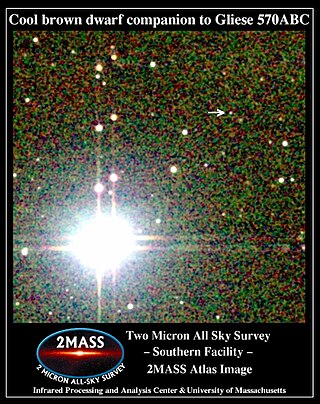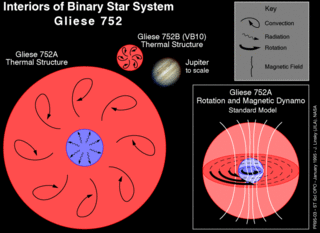
Gliese 570 is a quaternary star system approximately 19 light-years away. The primary star is an orange dwarf star. The other secondary stars are themselves a binary system, two red dwarfs that orbit the primary star. A brown dwarf has been confirmed to be orbiting in the system. In 1998, an extrasolar planet was thought to orbit the primary star, but it was discounted in 2000.
Gliese 65, also known as Luyten 726-8, is a binary star system that is one of Earth's nearest neighbors, at 8.8 light-years from Earth in the constellation Cetus. The two component stars are both flare stars with the variable star designations BL Ceti and UV Ceti.
Gliese 1 is a red dwarf in the constellation Sculptor, which is found in the southern celestial hemisphere. It is one of the closest stars to the Sun, at a distance of 14.2 light years. Because of its proximity to the Earth it is a frequent object of study and much is known about its physical properties and composition. However, with an apparent magnitude of about 8.6 it is too faint to be seen with the naked eye.
Gliese 674(GJ 674) is a small red dwarf star with an exoplanetary companion in the southern constellation of Ara. It is too faint to be visible to the naked eye, having an apparent visual magnitude of 9.38 and an absolute magnitude of 11.09. The system is located at a distance of 14.8 light-years from the Sun based on parallax measurements, but is drifting closer with a radial velocity of −2.9 km/s. It is a candidate member of the 200 million year old Castor stream of co-moving stars.

Gliese 105 is a triple star system in the constellation of Cetus. It is located relatively near the Sun at a distance of 23.6 light-years. Despite this, even the brightest component is barely visible with the unaided eye (see Bortle scale). No planets have yet been detected around any of the stars in this system.

Gliese 687, or GJ 687 (Gliese–Jahreiß 687) is a red dwarf in the constellation Draco. This is one of the closest stars to the Sun and lies at a distance of 14.84 light-years. Even though it is close by, it has an apparent magnitude of about 9, so it can only be seen through a moderately sized telescope. Gliese 687 has a high proper motion, advancing 1.304 arcseconds per year across the sky. It has a net relative velocity of about 39 km/s. It is known to have a Neptune-mass planet. Old books and articles refer to it as Argelander Oeltzen 17415.
Gliese 673 is an orange dwarf star in the constellation Ophiuchus. It has a stellar classification of K7V. Main sequence stars with this spectra have a mass in the range of 60–70% of solar mass (M☉).
Gliese 412 is a pair of stars that share a common proper motion through space and are thought to form a binary star system. The pair have an angular separation of 31.4″ at a position angle of 126.1°. They are located 15.8 light-years distant from the Sun in the constellation Ursa Major. Both components are relatively dim red dwarf stars.
Gliese 86 is a K-type main-sequence star approximately 35 light-years away in the constellation of Eridanus. It has been confirmed that a white dwarf orbits the primary star. In 1998 the European Southern Observatory announced that an extrasolar planet was orbiting the star.

Gliese 752 is a binary star system in the Aquila constellation. This system is relatively nearby, at a distance of 19.3 light-years.
Gliese 433 is a dim red dwarf star with multiple exoplanetary companions, located in the equatorial constellation of Hydra. The system is located at a distance of 29.6 light-years from the Sun based on parallax measurements, and it is receding with a radial velocity of +18 km/s. Based on its motion through space, this is an old disk star. It is too faint to be viewed with the naked eye, having an apparent visual magnitude of 9.81 and an absolute magnitude of 10.07.
HD 126614 is a trinary star system in the equatorial constellation of Virgo. The primary member, designated component A, is host to an exoplanetary companion. With an apparent visual magnitude of 8.81, it is too faint to be seen with the naked eye. The system is located at a distance of 239 light years from the Sun based on parallax measurements, but is drifting closer with a radial velocity of −33 km/s.
Gliese 179 is a small red dwarf star with an exoplanetary companion in the equatorial constellation of Orion. It is much too faint to be visible to the naked eye with an apparent visual magnitude of 11.94. The system is located at a distance of 40.5 light-years from the Sun based on parallax measurements, but is drifting closer with a radial velocity of –9 km/s. It is a high proper motion star, traversing the celestial sphere at an angular rate of 0.370″·yr−1.

Stein 2051 is a nearby binary star system, containing a red dwarf and a degenerate star, located in constellation Camelopardalis at about 18 ly from Earth.
Gliese 809 is a red dwarf star in the constellation Cepheus, forming the primary component of a multi-star system. A visual magnitude of 8.55 makes it too faint to see with the naked eye. It is part of the Gliese Catalogue of Nearby Stars and is located about 23 light-years (ly) from the Solar System. Gliese 809 has about 70.5% the radius of the Sun and 61.4% of the Sun's mass. It has a metallicity of −0.06, which means that the abundance of elements other than hydrogen and helium is just 87.1% that of the Sun.
Gliese 180, is a small red dwarf star in the equatorial constellation of Eridanus. It is invisible to the naked eye with an apparent visual magnitude of 10.9. The star is located at a distance of 39 light years from the Sun based on parallax, and is drifting closer with a radial velocity of −14.6 km/s. It has a high proper motion, traversing the sky at the rate of 0.765 arcseconds per year.
GJ 3323 is a nearby single star located in the equatorial constellation Eridanus, about 0.4° to the northwest of the naked eye star Psi Eridani. It is invisible to the naked eye with an apparent visual magnitude 12.20. Parallax measurements give a distance estimate of 17.5 light-years from the Sun. It is drifting further away with a radial velocity of +42.3 km/s. Roughly 104,000 years ago, the star is believed to have come to within 7.34 ± 0.16 light-years of the Solar System.
Gliese 49 is a star in the northern constellation of Cassiopeia. Visually, it is located 106 arcminutes north of the bright star γ Cassiopeiae. With an apparent visual magnitude of 9.56, it is not observable with the naked eye. It is located, based on the reduction of parallax data of Gaia, 32.1 light-years away from the Solar System. The star is drifting closer to the Sun with a radial velocity of −6 km/s.

WD 0810-353 is a white dwarf currently located 36 light-years from the Solar System. This stellar remnant may approach the Solar System 29,000 years from now at a distance of around 0.15 parsecs, 0.49 light-years or 31,000 AU from the Sun, crossing well within the proposed boundaries of the Oort cloud. Such close proximity will almost certainly make its flyby the closest in the future, until the flyby of Gliese 710 occurs around 1.14 million years after the dwarf's flyby.







